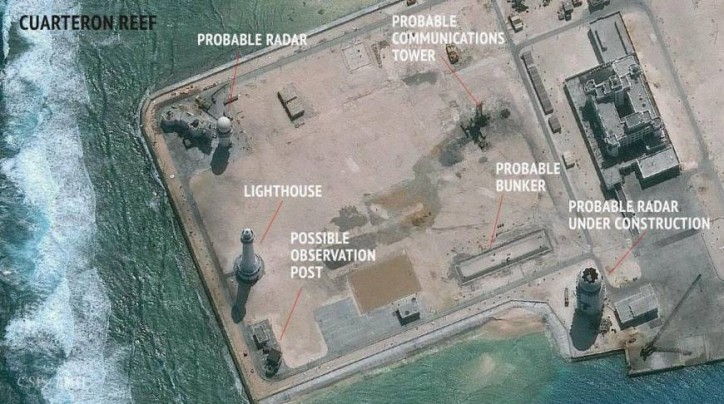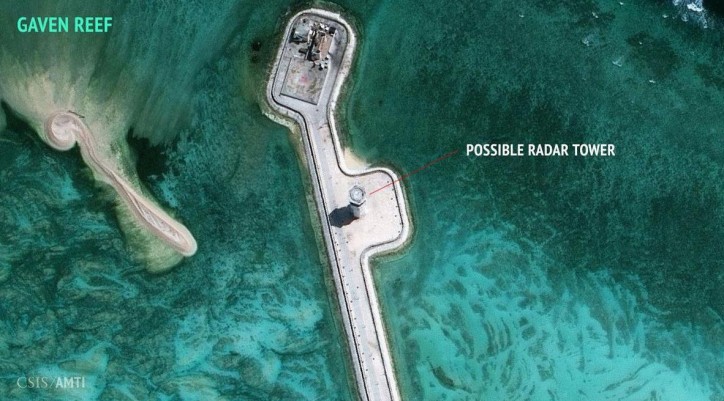China may be building a high-frequency radar installation in the disputed South China Sea, posing a bigger threat to the balance of power in one of the world’s busiest waterways than previously detected surface-to-air missiles, according to a report by the Center for Strategic and International Studies (CSIS).
Construction of radar facilities at Cuarteron Reef, the southernmost of the features China claims in the Spratly Islands, appears to be nearly complete, Gregory Poling of CSIS’s Asia Maritime Transparency Initiative wrote. China sparked new questions about its intentions in the South China Sea after surface-to-air missiles were detected earlier this month on Woody Island, part of the Paracel Islands northwest of the Spratlys.

Apparent radar facilities being built by Beijing are visible in this satellite photo taken Jan. 24 of the northern section of Cuarteron Reef in the South China Sea. | CSIS Asia Maritime Transparency Initiative / Digital Globe / Kyodo
“This month’s deployment of HQ-9 surface-to-air missiles on Woody Island in the Paracels, while notable, does not alter the military balance in the South China Sea,” said Poling. “New radar facilities being developed in the Spratlys, on the other hand, could significantly change the operational landscape.”
China claims more than 80 percent of the South China Sea in a contest with five rivals. Washington is concerned that China’s ultimate goal is the ability to exclude it from what it considers international waters. Along with the development of new runways and air defense capabilities on the islands it occupies in the Spratlys, the radar “speak to a long-term anti-access strategy by China — one that would see it establish effective control over the sea and airspace throughout the South China Sea,” Poling said.
The Chinese military has already been using the islands to monitor military and civilian traffic electronically but the new radar installations “will exponentially improve that capability”, said Euan Graham, director of the International Security Program at the Lowy Institute.
They would be highly vulnerable in conflict but would give China “a significant intelligence advantage — and make it much harder for the U.S. and other regional navies and air forces to move through the South China Sea undetected,” he added.
Asked about the radar installations, Chinese Foreign Ministry spokeswoman Hua Chunying said Tuesday that the area was Chinese territory “beyond dispute” and Beijing was entitled under international law to the “necessary and limited deployment of defense facilities.”
“Verbally, what the U.S. talks about is freedom of navigation, but in its heart, perhaps what it’s thinking about is absolute hegemony on the sea,” she said.
While the U.S. takes no sides on the various claims, it has taken actions it says are aimed at ensuring the freedom of navigation. More than $5 trillion of goods transit the South China Sea each year.
When asked about the missile deployment, Secretary of State John Kerry said last week that “there is evidence every day that there has been an increase of militarization of one kind or another.”
China says U.S. “freedom-of-navigation” operations, where it sails military vessels through territorial zones claimed by China and others, amount to militarization of the region and add to tensions. China dismissed as “hype” media reports about the deployment of HQ-9 missiles on Woody island, where its military has had a presence for years.
Adm. Scott Swift, Commander of the U.S. Pacific Fleet, said last week the latest deployment of HQ-9 missiles was the third time that
China had put them on the island, according to a report on U.S. website Military.com. The missiles also have been used in exercises, notably to shoot down a drone, he said.
“There is no difference between China’s deployment of necessary national defense facilities on its own territory and the defense installation by the U.S. in Hawaii,” the Chinese Foreign Ministry’s Hua said Monday. China contends that the islands it occupies “have been part of China since ancient times.”
White House spokesman Josh Earnest dismissed China’s analogy. “There is no other country that has a claim on Hawaii,” he said.
“But yet when you consider the land features in the South China Sea, there are a variety of overlapping territorial claims that a variety of countries have made on those features.” Woody island is claimed by Taiwan and Vietnam.
According to satellite images taken Jan. 24, China’s land reclamation on Cuarteron has expanded the reef to about 52 acres (210,400 sq. meters), Poling said. Two probable radar towers have been built on the northern portion of the feature, and a number of 65-foot (20-meter) poles have been erected across a large section of the southern portion.
These poles could be a high-frequency radar installation, which would significantly bolster China’s ability to monitor surface and air traffic across the southern portion of the South China Sea, he said.
The report also said the images showed that China appeared to have constructed a buried bunker and lighthouse on the northern portion of the feature, a helipad, communications equipment and a quay with a loading crane.
The CSIS report also noted the possibility that China may be building radar systems on other islands in the South China Sea, including Gaven and Johnson South reefs.

China previously operated radar sites on Fiery Cross reef, but the latest installations would give it far more extensive coverage, regional military analysts said.
China is looking to deploy “all the defensive and offensive capability means that it has” as it seeks regional dominance, said Jean-Pierre Cabestan, of Hong Kong Baptist University.
“In view of the weaknesses of other claimants, China will be able to dominate and then potentially control the South China Sea — its main objective being to force the U.S. Navy and Air Force to think twice before cruising or flying over the area,” he said.
In the last three or four years, the administration of U.S. President Barack Obama had become “more willing” to challenge Beijing’s claims in the South China Sea, said Lin Wencheng, of Taiwan’s National Sun Yat-sen University, adding: “The radar to some extent targets the U.S.’s military activities in this region.”
Source: TheJapanTimes